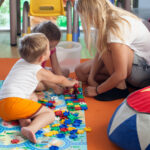Last post in this series on how to support multilingual children in settings from day care to preschool to school! This time we are off to Spain where Khalfaoui and colleagues looked at 14 studies to get a handle on what constitutes a positive classroom climate in multicultural early childhood education. When the classroom climate is positive, children benefit: their language development is better as is mathematical skill and behaviour. They describe 8 components divided into two categories. First up are pedagogical practices (for example, planning and carrying out learning activities) and there are 6 of these:
- increased instructional time and an emphasis on competences that foster cognitive development i.e. focusing on literacy
- teacher-student supportive interactions. Lot of things to consider here!
- When teachers support and encourage academic tasks, give feedback tailored to each situation and each child, ask for further information, repeat student contributions, and encourage participation from a place of respect and support without using sarcasm, there are fewer conflicts in the classroom and disruptive behaviours decrease.
- Being close to all students by knowing each child’s name, addressing them with a moderate tone of voice,
- Caring: when children feel cared for and included (via clear rules that provide security and certainty that their needs and demands are met) by the lead teacher
- Maintaining high expectations with all students has been found to impact classroom climate in culturally diverse early childhood education settings
- Several studies showed that during instructional time things like peer interactions & friendships where open dialogue and respect for speaking time boost relationships among students. Friendships in the classroom contribute to a positive climate by reducing conflicts, increasing student participation, and fostering safe and respectful environments.
- Having children actively engaged in activities and tasks is associated with emotional regulation. Successful emotion regulation influences children’s functioning in behavioural, academic, and social domains leading to a positive atmosphere in the classroom.
- Teacher-training on emotionally supportive environments was found to translate into more emotionally supportive, trust-based behaviours in their classrooms.
- Teacher-family trust-based relationships: This involves, for example, knowing the names of tudents and their families or legal guardians and establishing a cordial relationship with them when they are coming into school and going home. Teachers who have close relationships with students and their families tend to build an atmosphere of respect which can lead to children feeling motivated and excited learn.
Next, they report on structural aspects by which they mean things like class size and the physical classroom. There are two components to consider here:
- Group Size: small peer groups with clear rules that foster a safe space allows for more dialogue among the children. Collective moments or dialogues open to the whole class contribute to lower amounts of conflict when children work in smaller groups.
- Physical space: materials shared among children e.g. no names on pencils, invites peer-to-peer sharing and favours a positive classroom environment. They call these community materials. Literature that references the cultural diversity of the class is important. Picture books shared by young children in the classroom, children engaging in interactions around the books, creating a supportive literature environment in which children also share their experiences from their diverse social back-grounds. Bilingual books or wordless picture books can be a good addition to your class library. Not all bilingual books are created equal though! Will have a blog post coming soon on this.
So there you have it! 7 posts with 35 research-backed strategies for supporting multilingual children from day care through preschool to primary school! Phew! Which of these do you already do? Which ones would you like to try? Which ones just wouldn’t work in your context? Be sure to head over to the Talk Nua Facebook Page and let me know!
If you like this post, please share!
What I read so you don’t have to:
Khalfaoui, A., García-Carrión, R., & Villardón-Gallego, L, (2021). A Systematic Review of the Literature on Aspects Affecting Positive Classroom Climate in Multicultural Early Childhood Education. Early Childhood Education Journal, 49: 71-81.










